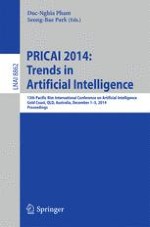This book constitutes the refereed proceedings of the 13th Pacific Rim Conference on Artificial Intelligence, PRICAI 2014, held in Gold Coast, Queensland, Australia, in December 2014. The 74 full papers and 20 short papers presented in this volume were carefully reviewed and selected from 203 submissions. The topics include inference; reasoning; robotics; social intelligence. AI foundations; applications of AI; agents; Bayesian networks; neural networks; Markov networks; bioinformatics; cognitive systems; constraint satisfaction; data mining and knowledge discovery; decision theory; evolutionary computation; games and interactive entertainment; heuristics; knowledge acquisition and ontology; knowledge representation, machine learning; multimodal interaction; natural language processing; planning and scheduling; probabilistic.
